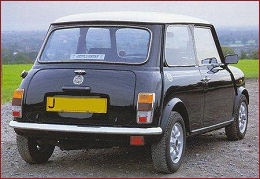 |
On the outside, the Mainstream was originally available in three colour schemes, Flame Red, British Racing Green Metallic and Black, all with a White Diamond roof. Storm grey Metallic, White Diamond and Quicksilver schemes, all with a black roof, were soon added to the range. Although the car has the familiar “Cooper” contrasting roof, bonnet stripes were omitted from the factory spec.
The bumpers, door handles and boot handle are all chrome plated and the standard "Cooper" chrome finish eight bar grille is used. Rear quaterlights are the opening type with chrome frames.
|
|